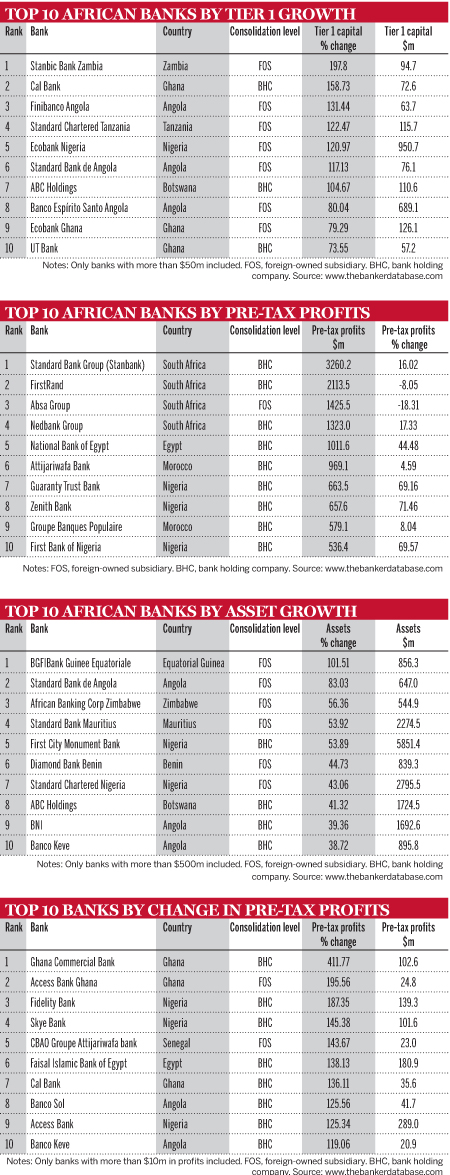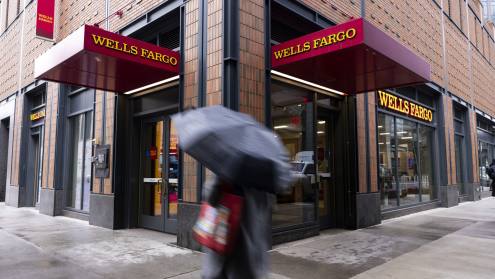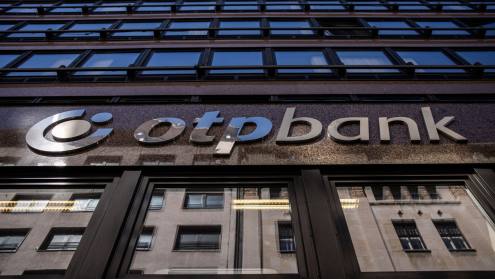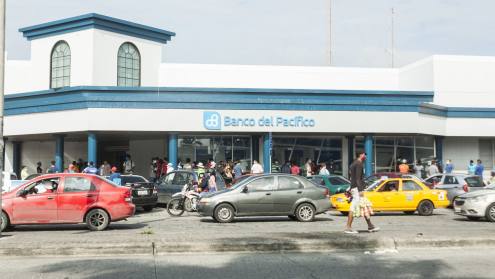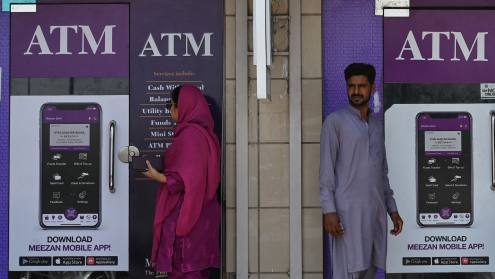Nigerian banks have plenty to get excited about in this year’s Africa ranking, which comprises the continent’s top 400 lenders by Tier 1 capital. Last year, Nigeria’s lenders made combined pre-tax profits of $499m. In the latest ranking, that figure has soared to $3.7bn, underscoring their recovery from the country’s financial crisis of 2009, which forced the government to bailout several lenders and nationalise three.
Editor's choice
Of the three institutions that the state took over, and which it hopes to privatise in the next few years, two of them have entered the ranking for the first time since they were restructured and rebranded. Mainstreet, previously called Afribank, made a pre-tax profit of $150m, amounting to a hefty return on capital (ROC) of 40%. Keystone, which used to be called Bank PHB, has a bigger balance sheet than Mainstreet ($2.5bn versus $2bn), but made far smaller pre-tax earnings of $18m.
Further demonstrating Nigeria’s success, three of its banks – Guaranty Trust Bank, Zenith and First Bank of Nigeria – made profits before tax of more than $500m, a figure no lender from the country had reached previously.
Other Nigerian institutions also performed well. Union Bank, which in the 2013 ranking made a $773m loss, the largest on the continent, generated a $58m profit this year. United Bank for Africa managed to turn a $180m loss last year into a $360m gain this time around.
On an individual basis, Nigeria’s banks did not make much headway in the ranking. The country has five banks among Africa’s top 20 by capital, the same number as last year. But when looked at collectively, they are rising quickly. Their assets increased from $113bn in 2013 to $134bn this year. In next year’s ranking they could well overtake Morocco’s banks, which have $137bn of assets, up from $121bn in 2013. If so, Nigeria’s banking sector would become the third largest on the continent after that of South Africa and Egypt.
South Africa remains king
South Africa dominates the ranking yet again. Like last year, the top four lenders in the overall ranking – Standard Bank, FirstRand, Absa Group (now called Barclays Africa Group) and Nedbank – come from there. Standard Bank, which saw its Tier 1 capital jump 10% to $10.9bn, extended its lead over Africa’s second largest lender, FirstRand, whose capital increased by 4.4% to $7.8bn.
The four banks’ pre-tax profits totalled $8.1bn in the latest ranking. Although this figure is more or less unchanged from last year, they still churn out far higher profits than banks elsewhere on the continent. Standard Bank’s profits of $3.3bn on their own were roughly equal to the profits of the 10 largest sub-Saharan lenders outside South Africa.
In terms of asset growth, the picture for South Africa’s big four was less rosy. Nedbank’s balance sheet expanded by 0.94%, but the other three all experienced a fall in assets in dollar terms, which was partly a result of the rand weakening against the US currency in 2012, but which also reflected the country’s slowing economy.
The rise of African Bank and Capitec – two South African lenders specialising in unsecured lending and which have grown rapidly in the past decade – continued. African Bank’s assets climbed 24% to $7.7bn and its Tier 1 capital 34% to $999m. Capitec increased its capital by 44% to $932m, allowing it to move up eight places in the ranking from 31st to 23rd.
Egyptian resilience
The larger north African banks grew significantly more quickly than their South African counterparts. Morocco’s Groupe Banques Populaire and Attijariwafa Bank expanded their capital bases this year by 13% and 21%, respectively, to $3.2bn and $3.1bn. Egyptian lenders, despite the political ructions faced by the country in 2012, were also buoyant. State-owned National Bank of Egypt, Africa’s 10th biggest lender, grew its Tier 1 capital by 24% to $2.4bn. Its profits before tax jumped to $1bn, up from $700m in 2013.
Aside from Nigeria, several other sub-Saharan countries had highly profitable years. Among them was Ghana, whose banks have benefited handsomely from a high interest rate environment and wide spreads in the foreign exchange market. The 22 lenders from the west African country that made the ranking generated a huge aggregate return on assets of 4.7%, almost two percentage points above what banks in Nigeria managed and 2.8 points higher than those in South Africa. Ecobank’s local subsidiary, which is Ghana’s biggest bank by assets, increased its profits by 46% to $99m, which amounted to an ROC of 79% and return on assets of 5.4%.
East African banks shone once again. Of the 10 biggest in Kenya, all bar one, Barclays Kenya, made record pre-tax profits. Kenya Commercial Bank, the largest lender in the country, increased its assets by 10% to $4.3bn and became the first Kenyan bank to post earnings before tax of more than $200m. Only two of the 10 Ethiopian banks in the ranking made an ROC of less than 30%, while in Uganda the four largest lenders all made ROCs of more than 50%.
Ecobank stands out
In the non-English-speaking parts of sub-Saharan Africa, profit growth tended to be more subdued. In oil-rich Angola, which had a booming banking sector for most of the past decade, lenders have started to feel the effects of lower interest rates, higher taxes and growing non-performing loans. Its biggest lender by assets, Banco Angolano de Investimentos, increased it capital by 24% to $669m. However, its balance sheet shrunk by 9% to $10.8bn and its net profit fell by 7% to $185m after it hiked provisions for bad assets. The next three biggest Angolan banks by assets – Banco de Poupança e Crédito, Banco Espírito Santo Angola (BESA) and Banco de Fomento Angola – all saw their profits fall in 2012 (the ranking has data from BESA’s 2011 results, as it is yet to release full accounts for 2012, but its Portuguese parent, Banco Espírito Santo, has stated that its profits fell during that year).
In Francophone Africa, few countries stood out for having particularly high Tier 1 or profit growth. One of the few was Côte d’Ivoire, whose economy, the biggest in French-speaking west Africa, continues to recover quickly from severe political unrest in 2011. SGBCI, the largest Ivorian bank and a subsidiary of France’s Société Générale, expanded its balance sheet by a small 4% to just over $1.6bn. But its profits went up by 54% to $57m. Ecobank Côte d’Ivoire, the country’s number two lender by assets, managed to boost its profits from $22m in last year’s ranking to $26m this time.
Togo-based Ecobank, which with subsidiaries in 34 African countries is the most geographically spread bank on the continent, performed strongly. Its Tier 1 capital rose by 55% to $2bn, although this was only enough to drag it up one place from last year’s ranking to 13th. It posted record net profits before tax of $348m, up 25% from last year.
The Banker's Top 400 African banks ranking, 2013 originally appeared in the January 2014 issue of the magazine. The full results of the ranking are available on The Banker Database. Find out more about the database, register for a free trial or subscribe today.



